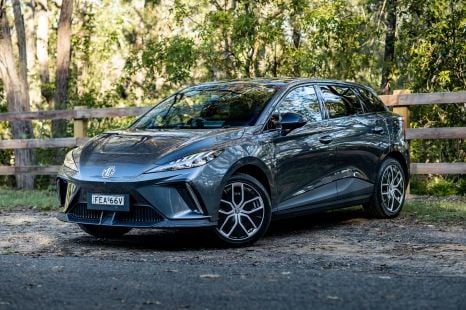

Matt Campbell
3 Months Ago
As a milestone in affordable electric vehicle ownership, the MG ZS EV just needs to be a good enough. It turns out it’s much better than that in the real-world experience.
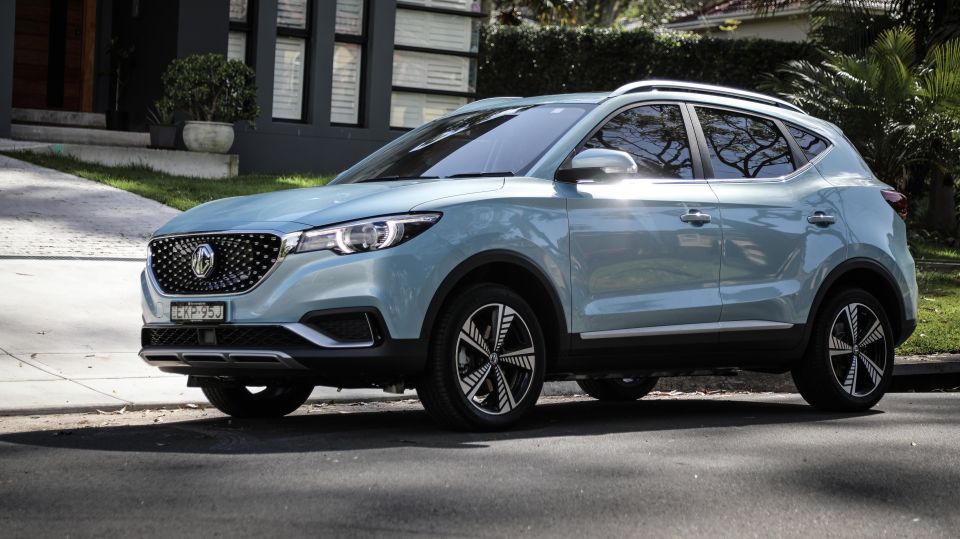
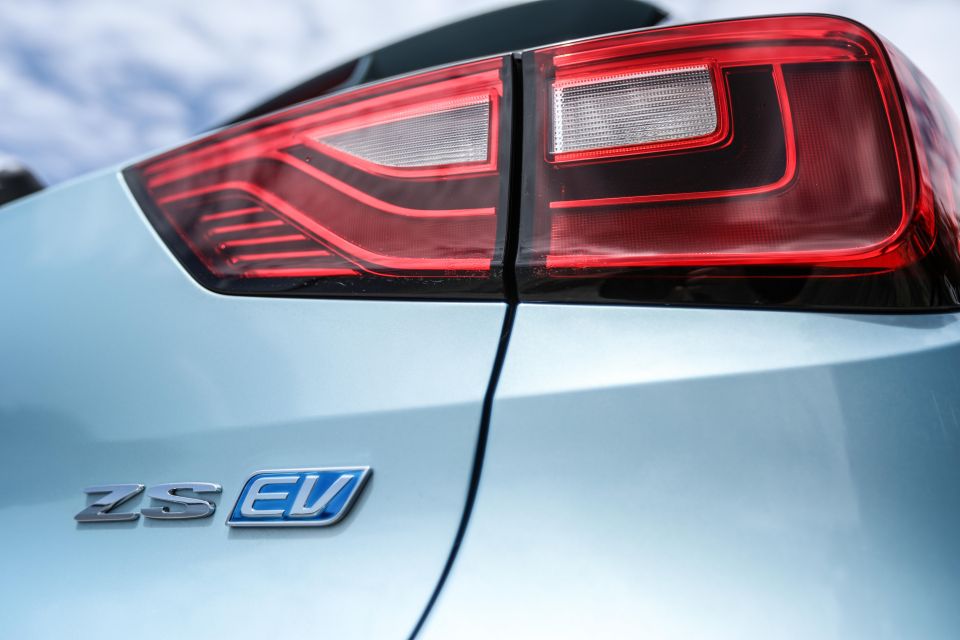

Journalist

Journalist


Journalist

Journalist
Take advantage of Australia's BIGGEST new car website to find a great deal on a MG ZS EV.
“Electric for everyone” is MG’s confident catchphrase for its new foray in fully electrified motoring. Realistically, not everyone can afford its roughly $46,000 investment also taking into account on-road costs and wall charger installation.
Projected supply to Australia is capped at around 3000 vehicles to the end of 2021 if MG’s stars align, but that doesn’t take away from what the brand has achieved with its somewhat pedestrian-looking electric SUV, marking a milestone in accessible electric-car ownership for Aussie buyers.
If all goes to plan, the MG ZS EV should have a profound and stimulating impact on electric motoring acceptance in Australia. Suddenly, EVs have become that much more ‘normal’ and perhaps unremarkable – and that’s exactly the right next step for widespread EV adoption.

How does the ZS EV stack up as a small-SUV prospect against hybrid or internal combustion alternatives for similar money? Good question.
How comparatively humble is the ZS EV’s battery power, range, and performance compared with pricier, more exclusive and established EV figureheads on the market? Fair pondering. But both areas of analysis jump the gun in overlooking the ZS EV’s largest dangling carrot and, perhaps, its whole point of being – viable EV mobility on a realistic budget.
You get what you pay for. And thus, what are the realistic expectations for an EV on a realistic budget? In this reviewer’s opinion, it’s much like a refrigerator – it needs to function as an appliance as promised ‘on the box’, reliably and with normality without much in the way of compromise, and to meet reasonable expectations of quality.
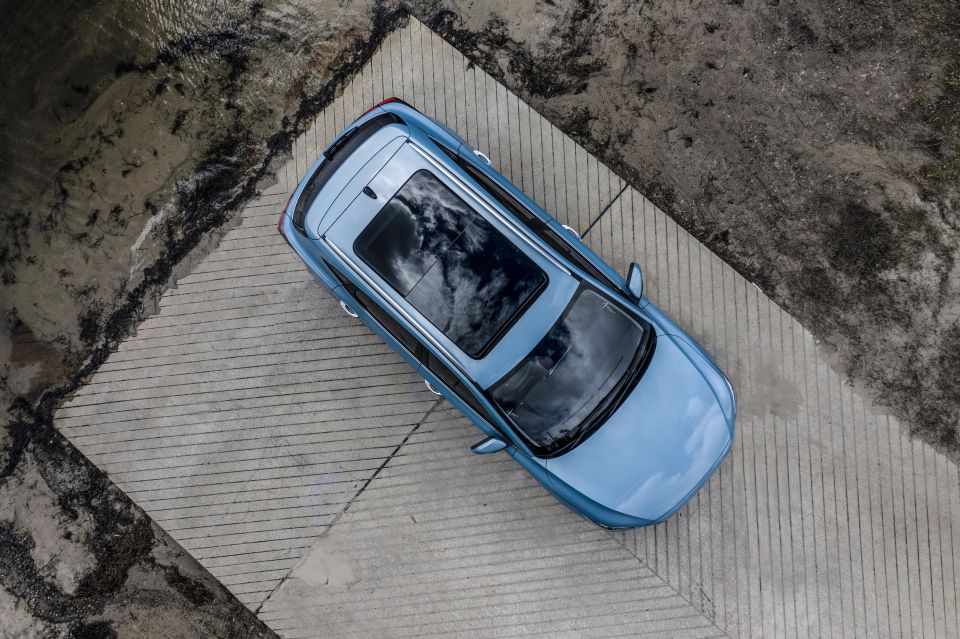
It’s a bit unrealistic to expect much in the way of the frills you’ll find in pricier competitors because, logically, a fair chunk of your outlay is returned in core electro-mechanical engineering.
Even the plain, innocuous, none-more-derivative styling is part of the ZS EV’s charm for no other reason than it’s kind of the point.
That was my mindset entering into the ZS EV experience at its local Australian launch – does it cover off the key fundamentals for its positioning, at least in EV terms. I came away much more impressed than I’d bargained for.

The ZS EV launches at $43,990 drive-away, off the back of a $40,990 list price. In early pre-sale in the lead up to the local release, MG Australia had priced the newcomer at $47,990 on the road.
Add “a couple of grand” to that for the wall box charger that can be arranged through MG dealerships, for around $46,000 all up. Yes, it comes with a portable emergency charger, but realistic EV ownership demands a realistic domestic charging unit.
That it’s cheap for an EV goes without saying, but we’ll say it anyway. It undercuts the funky Hyundai Ioniq Electric Elite ($48,970 list) by close to $10,000 once on-roads are considered but, closer to its SUV body, is $16,000 more affordable than the Kona Electric SUV ($60,740 list).
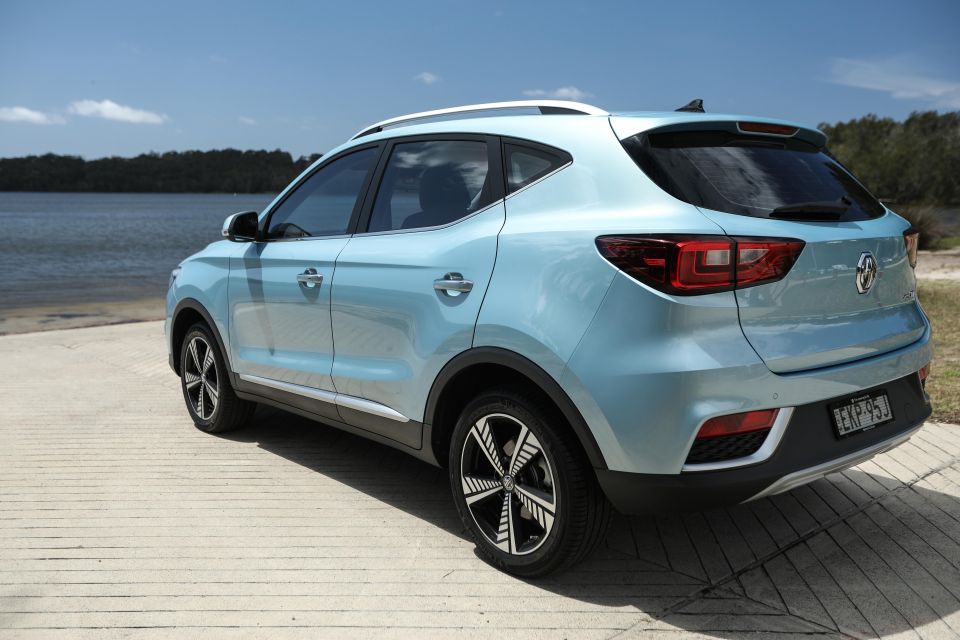
The now-defunct Renault Zoe Intens ($50,050 list) and Nissan Leaf ($49,990 list) are two buck-banging small EV hatch alternatives, and from here it’s Tesla Model 3 ($66,900 list) before price leap towards the likes of Audi E-Tron (from $137,100) and Porsche Taycan (from $190,400 list). Plus in many cases there’s extra wall-charger cost.
The ZS EV is pricey for a small SUV – its own range kicks off at $23,490 for the base Excite. That you’re really struggling to spend as much on any regular mainstream-badged small crossover is a strong suggestion MG’s electric family hauler is more ‘priced right’ than a gob-smacking SUV bargain.
There is only one specification offered right now, available in five colours. Three are metallic, and priced at an extra $500 including the EV-exclusive Clipper Blue you see here.
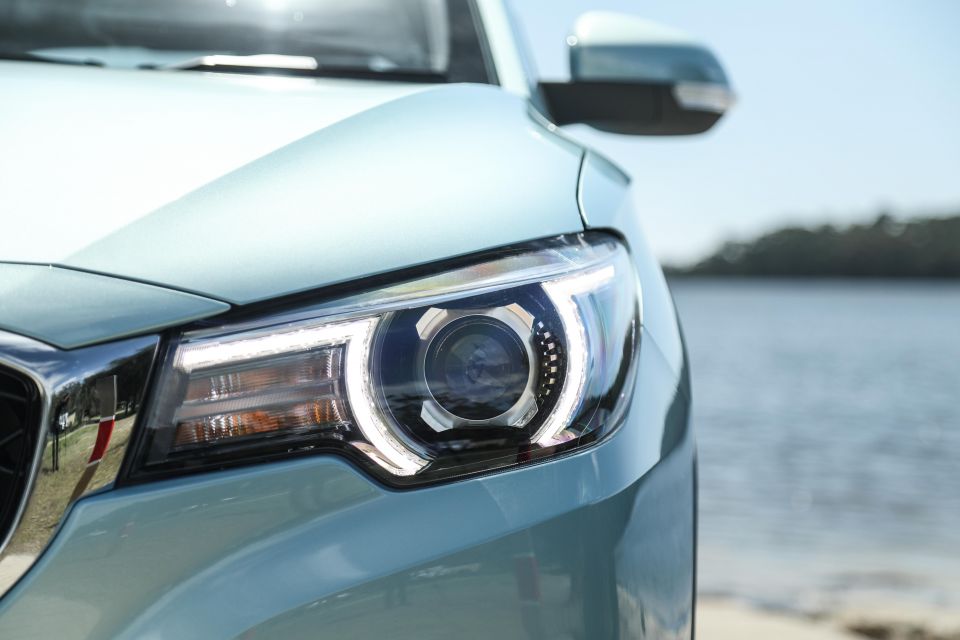
Outside, the ZS EV gets automatic halogen projector headlights and halogen tail lights – the daytime-running lights are LED – as well as 17-inch wheels (with Michelin rubber), a standard panoramic glass roof, rear parking sensors, and power-folding electric side mirrors.
Inside, the cabin has sports seats with six-way electric driver’s adjustment, faux leather trim, front seat heating, single-zone air-con, keyless go, a leather-trimmed wheel, analogue instruments with colour driver’s screen and digital speedo, an electric park brake, and adaptive cruise control with stop/go.
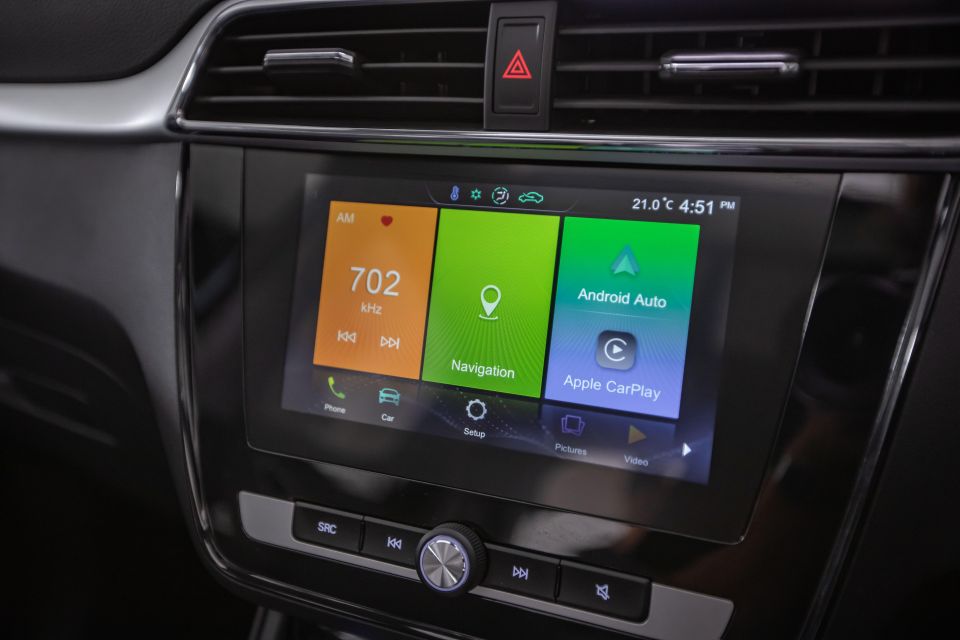
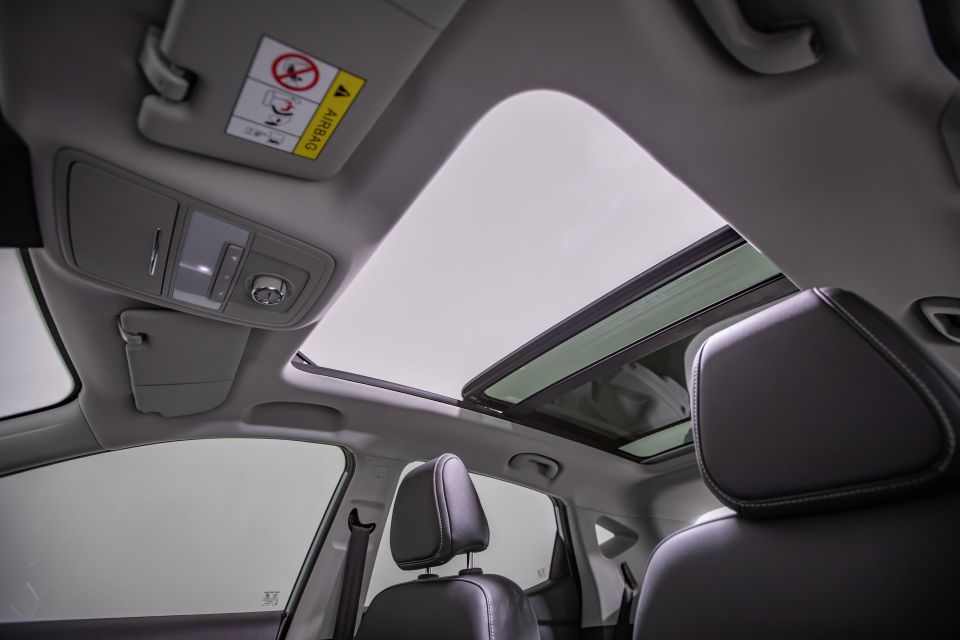
Perhaps due to packaging concessions of EV hardware, it’s equipped with a tyre inflator kit rather than a spare wheel and, thankfully, tyre pressure monitoring is featured.
The 8.0-inch touchscreen infotainment system brings with it a reversing camera, proprietary satellite navigation, AM/FM radio (but no DAB+), Bluetooth, six-speaker audio, and wired Apple CarPlay and Android Auto.
Bar the glass roof and seat heating, the equipment list is mostly a box-ticking affair that’s neither lacking nor overly lavish in any area.
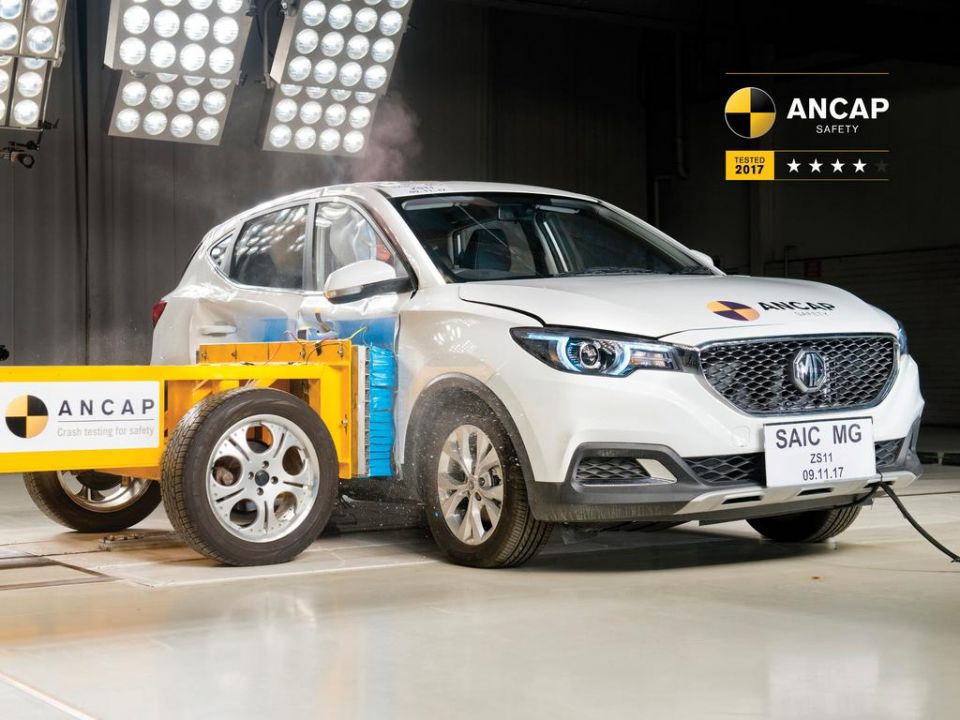
The MG ZS range was awarded a four-star ANCAP rating back in 2017 prior to the introduction of key active safety systems – including AEB – to the new ZST which is now sold alongside the ageing standard ZS.
However, the key measure for the somewhat technically different and vastly more safety-equipped EV variant is its five-star Euro NCAP assessment from 2019.
In Euro NCAP testing the ZS EV scored 90 per cent for adult occupant protection, 85 per cent for child occupant protection, 64 per cent for vulnerable road user protection, and 70 per cent for safety assistance.
As for ANCAP, the ZS EV was “undergoing testing at the moment” at the time of writing.
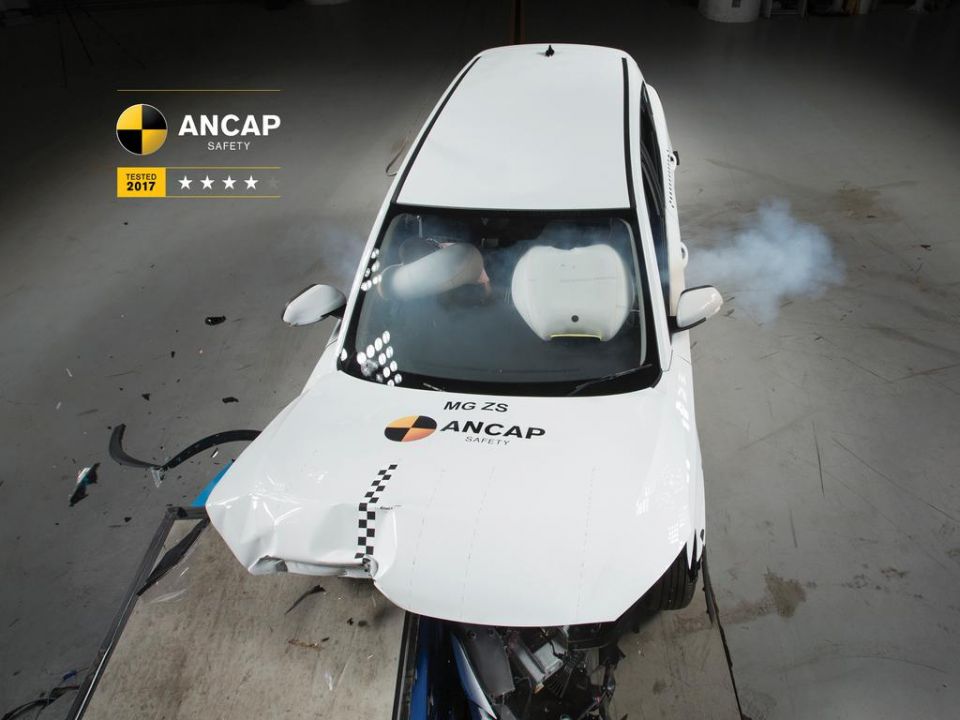
It fits six airbags as well as a range of standard kit under the ‘MG Pilot’ marketing banner including autonomous emergency braking (AEB), forward collision warning, lane departure warning, auto high-beam, blind-spot monitoring, rear cross-traffic alert, and speed sign recognition with overspeed warning.
Absent is active lane-keeping (and the associated lane centring convenience function) and there’s no auto-steering parking assistance that’s becoming a common feature in mainstream motoring.
That said, interestingly, MG’s literature states Traffic Jam Assist activation “automatically follows the vehicle in front, controlling acceleration, braking and steering” in that the electric power steering and sensory technical suite can self-steer in certain conditions. Unfortunately we didn’t get a chance to test the system at the local launch.
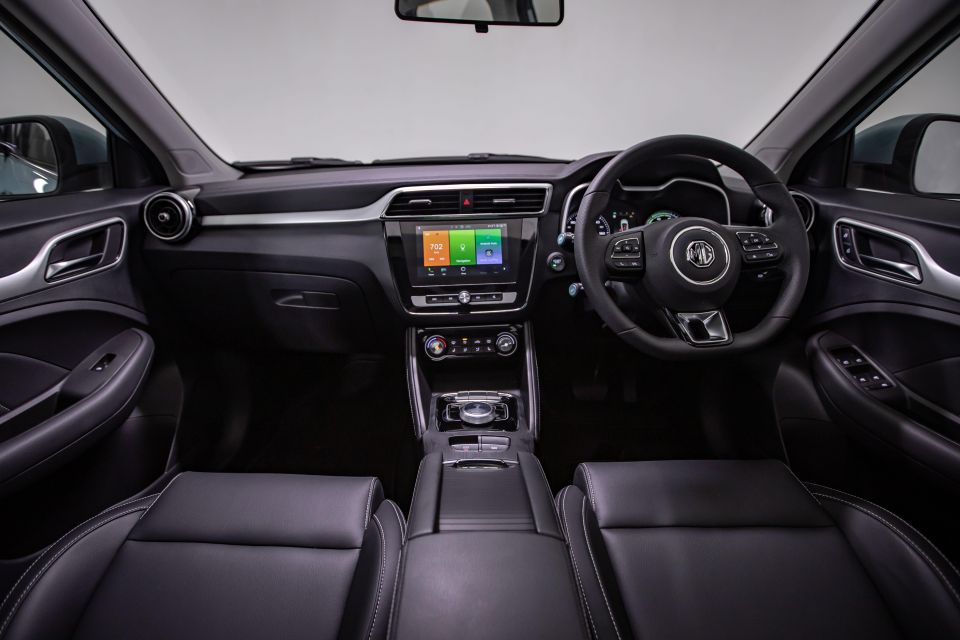
Climb in and the cabin space feels richer and more upmarket than the ZS EV’s pedestrian exterior prepares you for. It’s a class act of affordability done well – attractive design, deep colourisation with neat and stylish contrast in the right places, judicious use of satin sheen and textured surfaces, a sense of solidity and clean execution.
Sure, it’s pilfered details here and there, such as the Jag-like rotary transmission dial, and Audi-esque ‘turbine’ vents. But it’s no carbon copy of anything and embraces clever design tricks to make the most of itself.
The quality wheel with perforated leather rim, the strategically conspicuous metallic switchgear, the flush infotainment screen integration, the low-sheen leatherette that, while not quite convincingly real, is more supple and welcoming than a lot of stuff used at the ground floor of premium-badged German models.
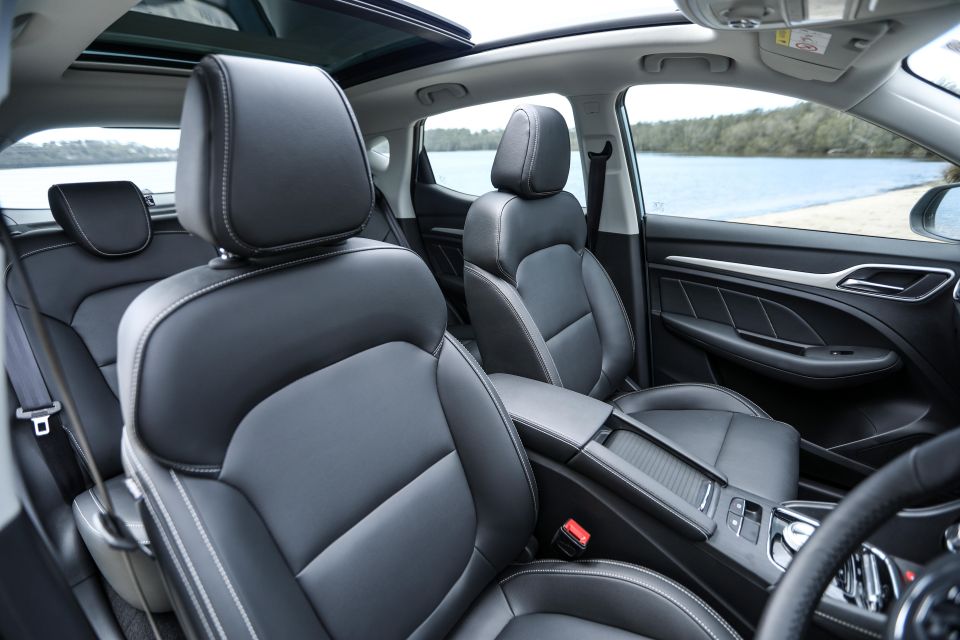

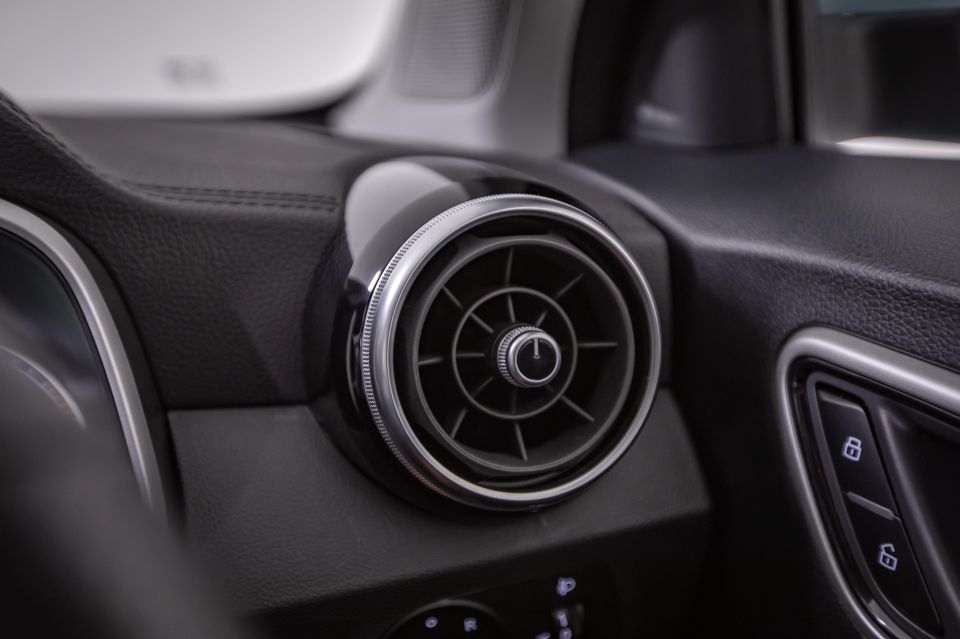
Ambience wise it looks damn good, and it feels pretty impressive, too.
Both the touchscreen and driver’s central display are bright, crisp, easy to read and navigate. There’s little in the way of silly EV telemetry data few give a toss about – just a simple flick of the Battery switch to momentarily display range to empty when you need it to augment the discrete instrument readout.
The user interface is friendly and largely unfussy, with a huge and handy reversing camera view and an impressively rich quality to the audio system. It’s a simple toggle in the console array to switch between the three drive modes and three levels of ‘KERS’ braking regeneration to taste.
The front seats are impressive. They look more heavily bolstered than they feel, offering a nice balance of lateral support and relaxed comfort with plenty of give in the cushioning, though the seatback itself does have a slightly pronounced hump.
The touch points are reasonably soft and it’s easy to settle in for long-haul comfort, the only gripes of note being that the cruise control stalk is hidden behind the wheel ‘old school’ style, and the wheel can obscure the battery charge readout at the bottom of the instrument binnacle, forcing you to lean forward to read it at a glance.
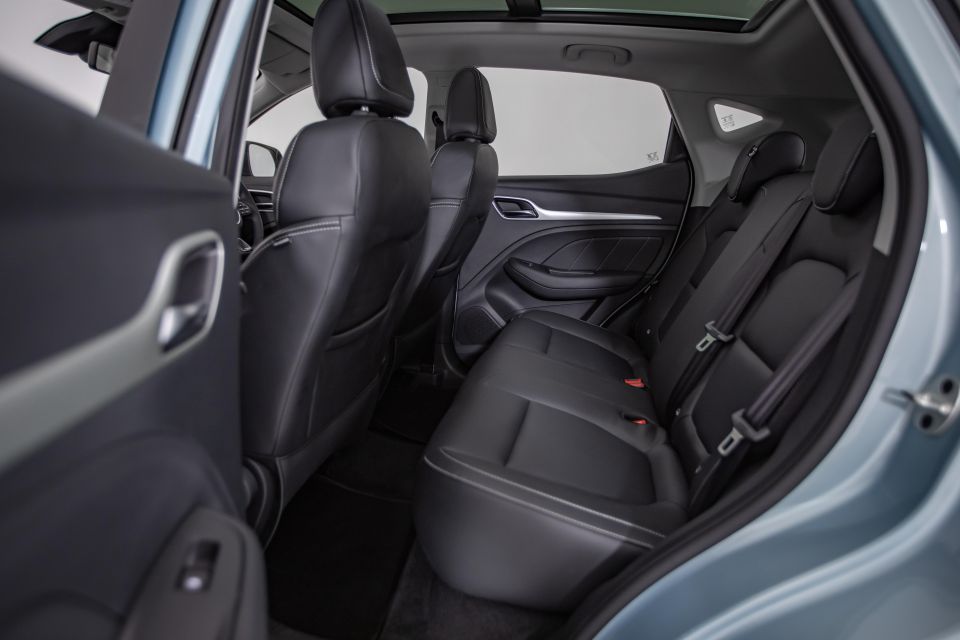
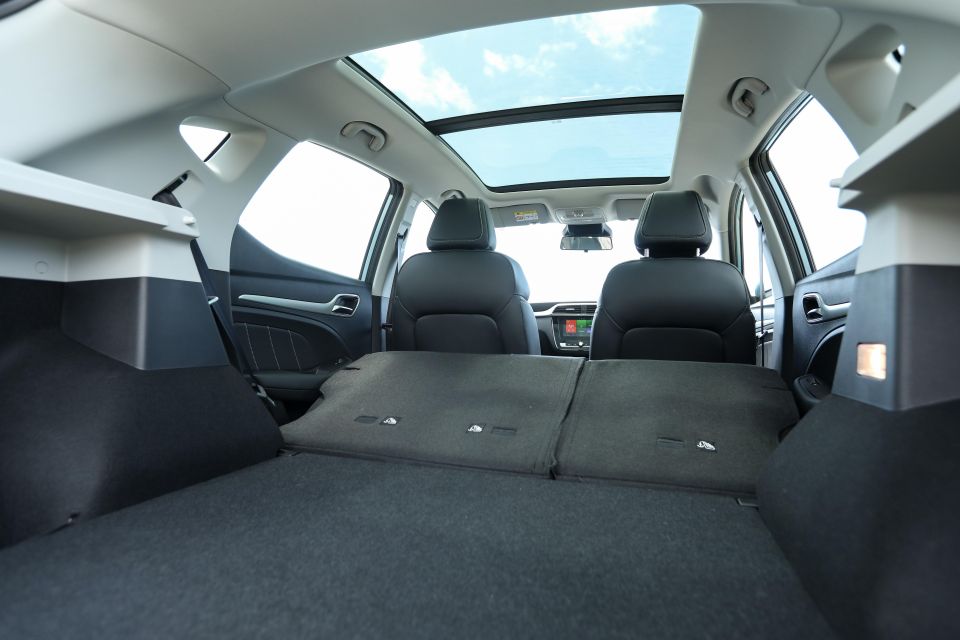
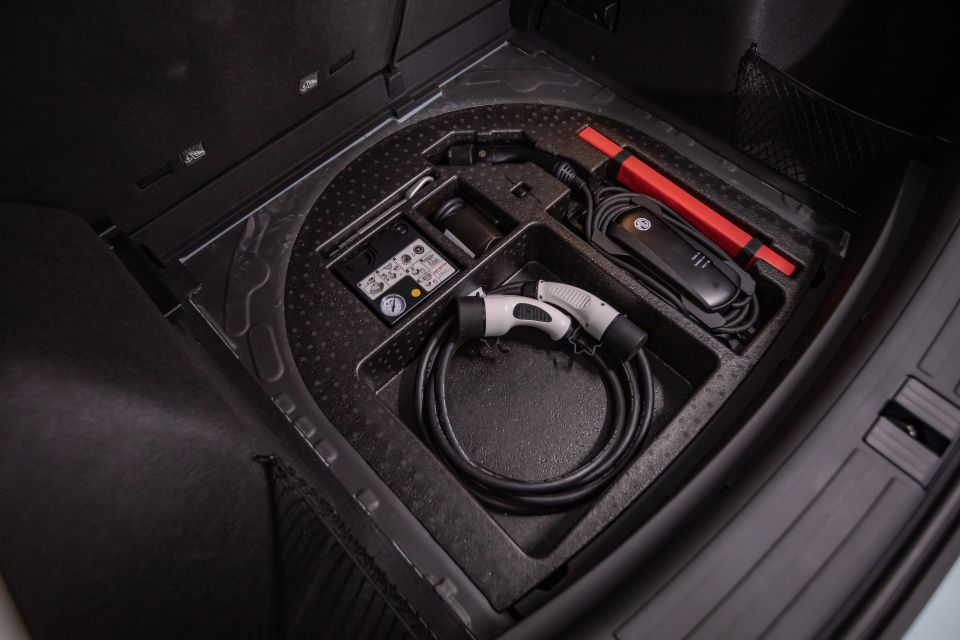
Rear accommodation is generous and impressive, with ample adult-friendly spaciousness in all directions and a flat hump-free floor for easy access and added foot room. The angles of the base and backs, too, offer relaxing posture that ideal for long hauling.
Despite the dark materials it remains pleasingly airy. The only real markdown a lack of rear air vents, though you do get a single USB-A outlet.
Further back, the boot is moderately wide but very deep with its dual-level floor panel set to the lowest position. Its quoted 357 litres is hardly segment-busting but in practice it’s a useable space large enough for two suitcases should you dare test its maximum range for longer trips, and the 60:40 split-fold rear drops to liberate 1166 litres.
The emergency charger sits in a cubby under the floor and it’s a pain to access though, logically, it’s intended for only occasional use anyway so this is no real ownership deterrent. Without it, and with the floor set to its higher position, there’s easily enough room for a space-saver spare.
All in all, the ZS EV rates handsomely in the cabin. The designers have not only done a fine job maximising the packaging, the presentation and sense of quality is quite impressive for a device firmly positioned as price-busting prospect.
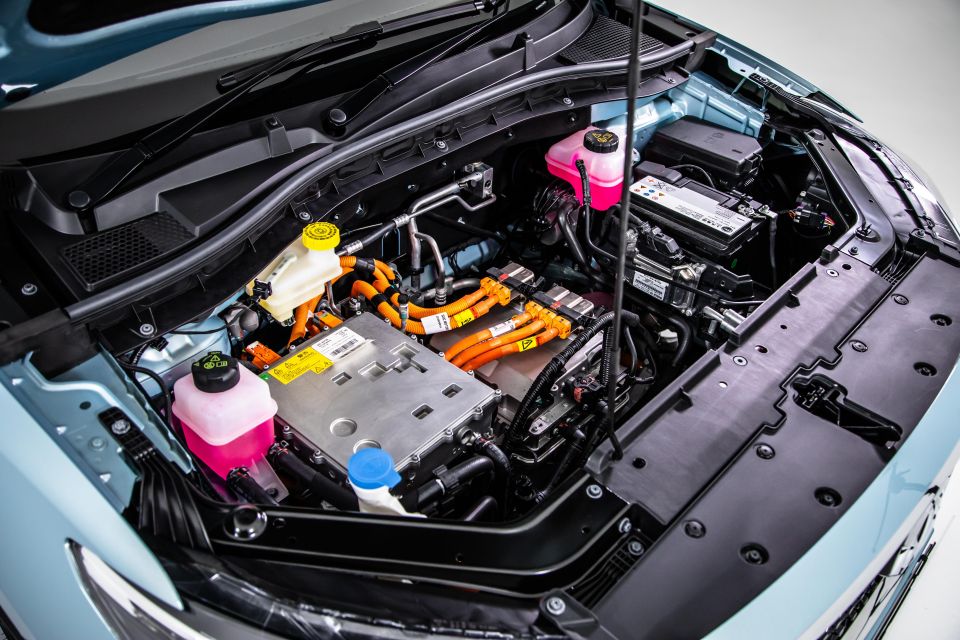
The MG ZS has fairly modest credentials compared with some EV figureheads. The single e-motor drives the front wheels exclusively, producing 105kW and a fairly surly 353Nm for the SUV’s somewhat lithe 1532kg kerb weight.
At 44.5kWh the battery is quite a small one, and its WLTP-rated range of 263 kilometres on a full charge won’t give Tesla’s engineers cause for alarm.
But on paper, at least, it offers ample performance and range for regular daily use in an urban environment.
The ZS EV offers a claim of 0-100km/h in 8.8 seconds and, perhaps more crucially around town, a 0-60km/h boast of 3.1 seconds. No ground-breaker in electric terms but handy for a small SUV.
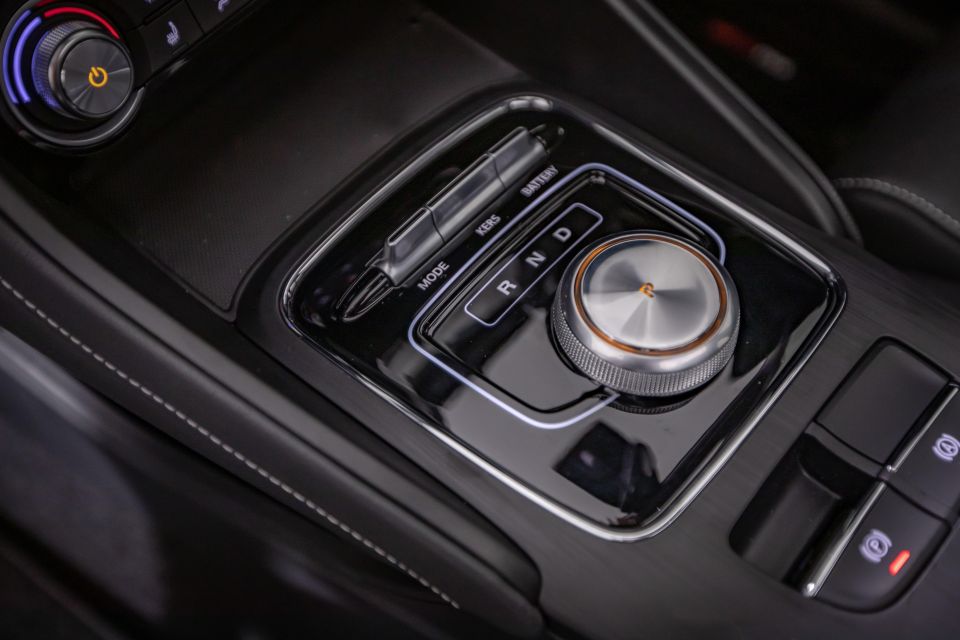
Find out more about the car
Further, while WLTP’s more balanced assessment for range seems merely adequate, MG publicly advertises the “city” range can be as much as 371 kilometres in a best-case scenario.
Though we didn’t get to fully test how driving style – and indeed the impact of drive mode and regen fiddling – directly impacts real-world range during the SUV’s launch program, evidence strongly suggested velocity and driving style definitely impacts the ZS EV’s indicated range by no small margin.
Recharging? There are CCS and Type 2 ports mounted in a panel behind the grille at the front of the vehicle. Using a 50kW DC rapid charger the battery will get to 80 per cent in 45 minutes. Using a 7kW AC domestic charger, a full charge takes around seven hours.
It’s also quite a lightweight piece of engineering. The motor and driveline assembly is set low in the engine bay, the 44.5kWh water-cooled lithium-ion battery lies flat between the axles under the floor, and there’s just a 50kg penalty to the weigh-bridge ticket over the petrol ZS, with much of the assembly offering a low centre of gravity that should return some dynamic dividend on-road.

The real highlight of the package is just how well it drives. It’s not merely decent, nor merely adequate. It’s very bloody good. Polished, refined, well sorted and impressively well calibrated – this is well beyond the realms of simply ‘make-do’ cheap electrified motoring.
Throttle response is immediate, off the mark or on the go, and left in default Normal mode there’s a nicely judged blend of response and restraint that demands no readjustment from a driver accustomed to the character of internal combustion. You treat the right foot like a volume control – the more you squeeze the more thrust it returns in perfect unison, and torque seems fulsome and effortless.
Eco dulls the response without sacrificing much thrust at all. It’s a marked enough drop to notice and ideal for slow traffic, then, not that Normal lacks low-speed flexibility in any way.
Equally, the lift in response and urgency in Sport is quite noticeable and, pinned to the carpet, it’s plenty quick – and more than quick enough – measured by the seat of the pants or the flow of traffic. Three useful and distinctive modes, then, though Normal covers such a broad range of driving needs you might never need to switch out of it.

The regenerative braking settings, too, are far from a gimmick. Its strongest ‘3’ mode offers enough natural deceleration for one-pedal driving in most situations – but it’s most satisfying when you let the ZS EV off its leash on a twisty back road as a sort of velocity modulation assistant.
Meanwhile, the mildest ‘1’ setting is a pretty close approximation to natural internal-combustion engine braking and it’s most welcome, mostly because on longer trips the usual throttle modulation demands of EV regeneration can be fatiguing on the right leg.
It’s whisper quiet and isolates road and ambient noise impressively well, which brings with it a real upmarket vibe. You do get some patter of tyres over cats eyes and some faint suspension noise, but that’s only because the rest of the package is so serene.
The instant wave of linear torque is such that it completely masks the modest net 50kg penalty of the EV powertrain and, thus, it’s as light on its tyres as your average small SUV. That lumbering ponderousness of heavy, big-battery EVs is non-existent and the benefit this brings to the daily driving experience, in your author’s opinion, is a worthy trade-off for outright range.
Unencumbered by excess mass and inertia, and with its low centre of gravity, the ZS EV is a real eye-opener once you stick it through some twisty corners. There’s crisp steering, a surprising amount of grip from its narrow 215mm Michelin Primacy tyres, and the sort of sweet balance that removing engine mass from under the bonnet and placing the battery between the axles ought to return.
That’s it isn’t a sports car is not the point – that it’s keenly cooperative to the driver’s whims as a function of safety and control most certainly is.
Then there’s the ride. It’s excellent. There’s a huge amount of pliancy in the damping and because there’s a decent amount of tyre wall (50-series aspect ratio) it rounds out small and large road imperfections with equal aplomb. Nor is it overly soft or under-damped as it still maintains a keen amount of body control and remains planted and predictable even across really rough stuff.
Had the powertrain impressed at the behest of a mediocre ride and handling package – not uncommon in EV realms – the ZS EV would’ve return generally positive on-road appraisal. Had the powertrain been neutered in trade for decent chassis behaviour – a few hybrids come instantly to mind – then you might’ve attributed the result to some ‘EV at a cost’ excuse.
Instead, the Chinese newcomer goes, rides and handles like a well-sorted champion. Given what this model sets out to achieve at this price point, it’s real eye-opener.
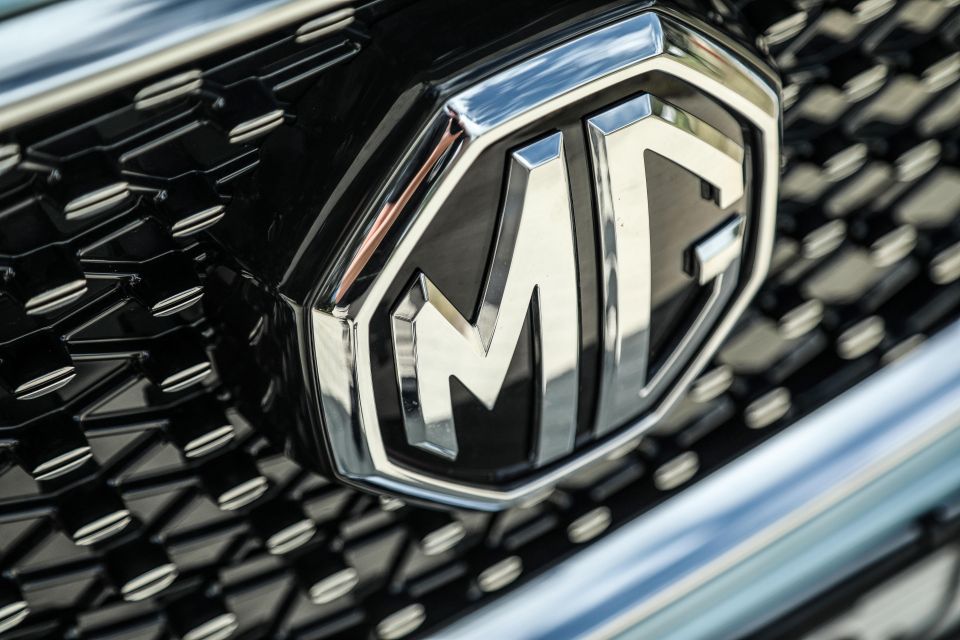
MG offers five years of unlimited-kilometre warranty on the vehicle. The battery pack has eight years and 160,000km of warranty coverage.
Servicing intervals are 12 months or a short 10,000km, whichever comes first, though it’s feasible a good many EVs won’t be subjected to high-mileage use.
Interval costs are between $168 and $271 across the first 84 months or 70,000kms, except a pricey $827 visit at the 48-month/40,000km mark. Averaged over the first five years, it’ll cost $320.40 per year to service.
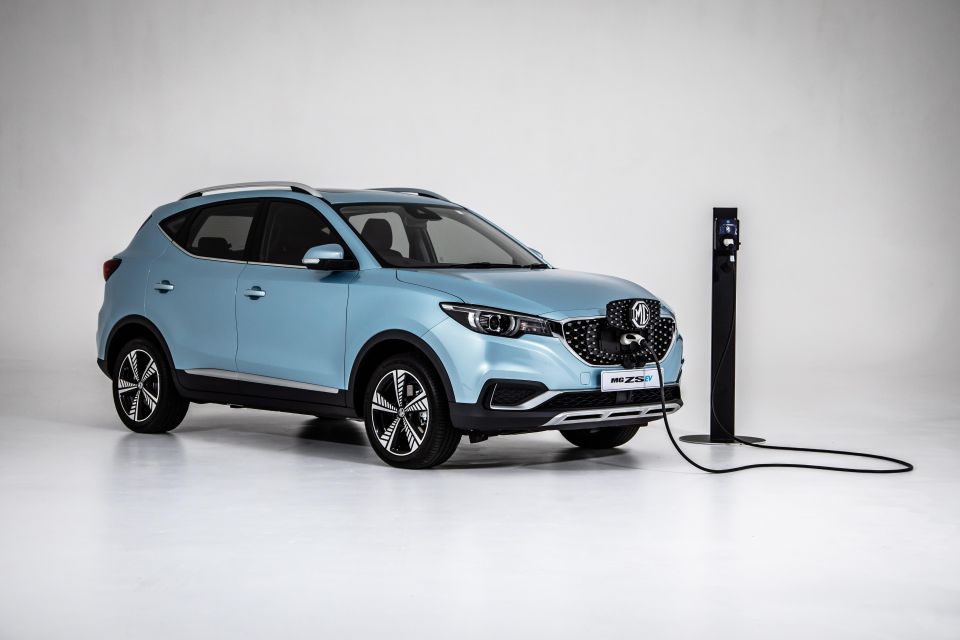
The MG ZS EV is most welcome to the Aussie motoring landscape because, in many ways, it’s exactly what its EV minority needs right now.
In many ways, it delivers what’s expected for the price. And equally, in many of the same ways and measures, that price is perhaps more fitting than it is a knock-the-socks-off bargain.
In other ways – cabin presentation, powertrain quality, ride and handling, general refinement and comfort – the ZS EV is really punching above its weight. Whether or not you’d sacrifice much or all of this goodness for less-capable motivation or a heftier battery and improved range is very much up for debate.
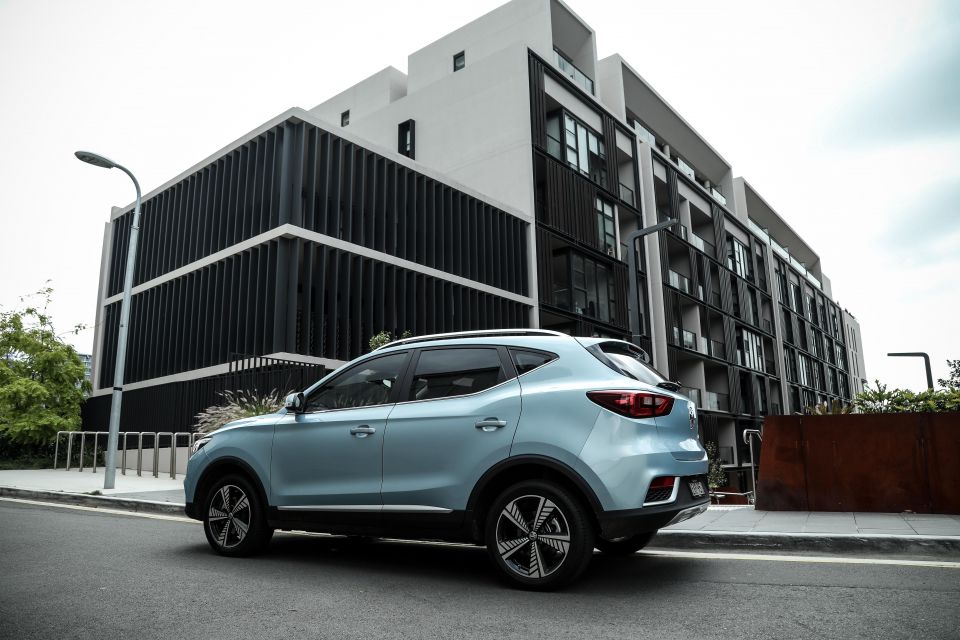
As it sits, this EV combination for the money looks just about right. If it proves that real-world city range is, as its maker claims on its public site, well into the thick end of the ‘threes’ then MG’s proposition is more enticing still.
Whatever the case, the new MG is most welcome to Aussie roads. It’s the kind of EV that, well, EVs need right now as a key step towards a more electrified future.
MORE: 2021 MG ZS EV – Why it’s a big deal MORE: 2021 MG ZS EV pricing and specs MORE: MG ZS news and reviews
Take advantage of Australia's BIGGEST new car website to find a great deal on a MG ZS EV.


Matt Campbell
3 Months Ago
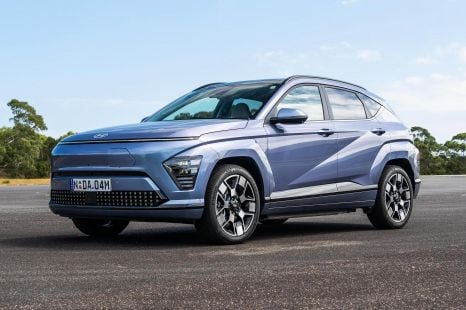

Scott Collie
3 Months Ago
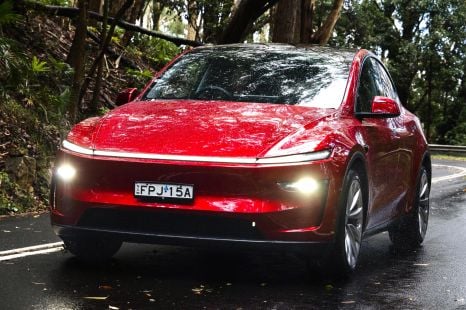

Max Davies
3 Months Ago
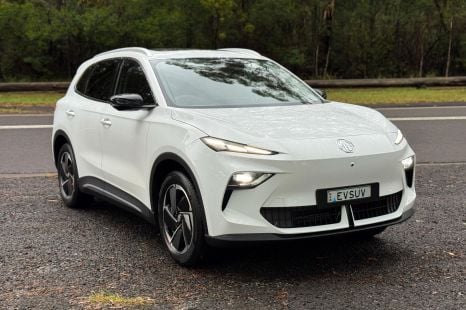

Matt Campbell
2 Months Ago
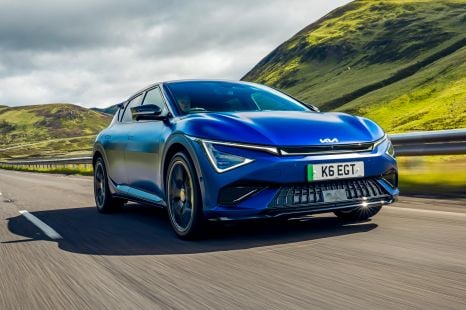

Matt Robinson
1 Month Ago
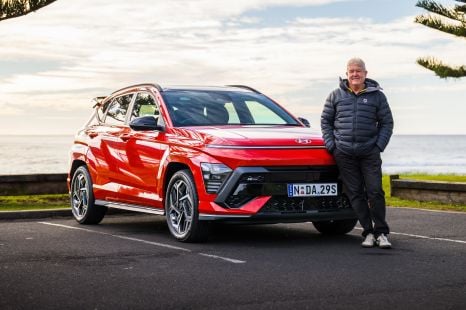

Anthony Crawford
1 Month Ago